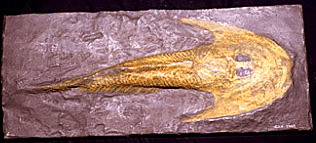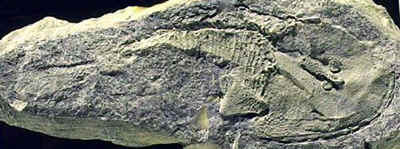
Cephalaspis as it would have appeared in life. Image from Lucius Fisher's Picasa album, original source unknown
| Cephalaspidomorphi: | ||
| The Vertebrates | Cornuata |
| Vertebrates Home | Vertebrate | Vertebrate |
|
Abbreviated Dendrogram
Vertebrata
├─Conodonta
└─┬─Pteraspidomorphi
└─Thelodonti
└─┬─┬─Katoporida
│ └─Cephalaspidomorphi
│ ├─Galeaspida
│ │ ├─Eugaleaspidiformes
│ │ └─Polybranchiaspidida
│ └─┬─Pituriaspida
│ └─┬─Osteostraci
│ │ ├─Ateleaspis
│ │ └─Cornuata
│ │ ├─Cephalaspidida
│ │ └─┬─Zenaspidida
│ │ └─┬─Benneviaspidida
│ └─Gnathostomata
└─┬─Loganiidae
└─Gnathostomata (alternative placement)
|
Contents
Overview |
 |
| Cephalaspis as it would have appeared in life. Image from Lucius Fisher's Picasa album, original source unknown |
Early Silurian to Late Devonian
Osteostraci::: Hemicyclaspis + *: Cephalaspidida + (Zenaspidida + Benneviaspidida + (Kiaeraspidida + Thyestiida))).
Mouth lined with elongate oral plates; branchial opening covered by folds or plates; $ pointed lateral processes (cornua) of the headshield, anterior to paired fins; $ oralobranchial fenestra posteriorly closed by a bar of dermal bone; paired fins narrow based and separated from trunk musculature.
Links: Untitled Document; Osteostraci.
References: Janvier (1996). ATW020615.
 Cephalaspidida: Cephalaspis, Mimetaspis, Parameteoraspis, Pattenaspis
Cephalaspidida: Cephalaspis, Mimetaspis, Parameteoraspis, Pattenaspis
Range: Late Silurian(?) to Early Devonian of Europe & Spitsbergen.
Phylogeny: Cornuata: (Zenaspidida + Benneviaspidida + (Kiaeraspidida + Thyestiida))) + *.
Characters: broad, flattened cornual processes (which may be very broad); lateral sensory fields extend onto cornua; retain some remnant of anterior dorsal fin (primitive); scale microstructure including long ridges and rows of osteocyte lacunae at base [M02].
Image: Cephalaspis from Biology 356.
Links: Osteostraci; Cephalaspis tenuicornis; Biology 356; Spittal Quarry; Le Dévonien 10/10); New Page 1 (some of these look almost too good to be true -- but interesting photos nonetheless); fossils.pdf; fish.doc; forelasning4.pdf Swedish); Ken Mannion Fossil Gallery; Dineley.
References: Janvier (1996); Märss 2002) [M02]. ATW020615
Notes: Ludlovian to Givetian Cephalaspis occurs in Britain and Spitsbergen (widespread - northeast to southeast Euramerica). Parameteoraspis, is the largest known osteostracan, the crestent-shaped shield reaching 35 to 40 cm in breadth. It is particularly abundant in Spitsbergen (northern Euramerica) but is lacking in Britain and Podolia (eastern Euramerica), and smaller cephalaspidids, such as Pattenaspis and Mimetaspis occur in Spitsbergen (northern Euramerica), Britain, Podolia, Rhineland (east and southeast Euramerica) and France (adjacent north Gondwana). MAK001023.
 Zenaspidida: Diademaspis, Machairaspis, Scolenaspis, Tegaspis, Zenaspis
Zenaspidida: Diademaspis, Machairaspis, Scolenaspis, Tegaspis, Zenaspis
Range: Early Devonian to Late Devonian of Europe and North America
Phylogeny: Cornuata:: (Benneviaspidida + Kiaeraspidida + Thyestiida)) + *.
Characters: headshield massive; hypophysial part of nasohypophysial opening enlarged; sensory fields posteriorly enlarged; some with tall median dorsal process near posterior of headshield; thick, narrow cornual processes; anterior dorsal scute lost; characteristic ornamentation of large tubercles, surrounded by smaller ones.
Image: Zenaspis from BIOLOGY 4402/5402.
Notes: Lochkovian to Frasnian. The Zenaspidida are usually large, massive osteostracans (average length about 25 cm), with a coarsely tuberculated ornamentation and a large hypophyseal foramen. They are abundant in the early Devonian of Britain, Podolia (east and southeast Euramerica) and Spitsbergen (northern Euramerica) MAK001023.
Links: Osteostraci; 309.htm; AGP, Volume 46, Number 3-4, 1996; 118.htm; PPT Slide; Home Page; New Page 1 two gorgeous pictures of Zenaspis).
References: Janvier (1996). ATW021221.
Benneviaspidida: Belonaspis, Benneviaspis, Boreaspis, Hoelaspis, Tauraspis.
Range: Early Devonian of Europe (including Spitzbergen) & Russia.
Phylogeny: Cornuata::: (Kiaeraspidida + Thyestiida) + *.
Characters: headshield flat and dorsoventrally depressed; some have two rostral processes or the cornual processes are bent anteriorly; first canal to lateral sensory field bifurcates near orbit; short-bodied; anterior dorsal scute absent; no separate tesserae and no radiating canals in the exoskeleton (see [1]).
Note: [1] osteostracan headshields have a rather complex histology. The outer layer is usually a continuous layer of dentine which may be coated with a thin enameloid. The middle layer is composed of cancellous (spongy) bone and has two divisions. The superficial portion often has a sort of pore-canal system similar to those of many sarcopterygians. The deeper layer is tesselated tiled) and usually has a pattern of vascular canals radiating from the center of each tile. The inner layer is laminar bone. In Benneviaspidids, the lower part of the middle layer is continuous. There are no visible separate tiles and the radiating vascular canals are absent. [2] Lochkovian to Emsian The Benneviaspidida have a very flat head shield and a short abdominal division. They include a group of small forms with long rostral process (Boreaspididae) and other highly derived head-shield morphologies. They are known from Britain, Podolia (east and southeast Euramerica), Spitsbergen and Severnaya Zemlya northern Euramerica) although the Boreaspididae are restricted to the northern region (hence the name - Boreo- north). At least 14 species of Boreaspis are known from fossil deposits of the lagoons of Spitsbergen during the Early Devonian. They differ in the width of their triangular-shaped head shields, and in the length of the bonv spine that grew out from the cheek area on either side. The snout was elongated in all species into a bladelike rostrum. As well as its hydrodynamic function, the rostrum was probably used to probe on the muddy lagoon floor for prey. Another genus in this suborder, Tauraspis,is unique in having two forwardly directed horns in place of the usual rostrum. MAK001023
Links: Osteostraci; 309.htm; 118.htm; PPT Slide; Early Devonian osteostracans from Severnaya Zemlya, Russia.
References: Janvier (1996). ATW040717.
checked ATW040717